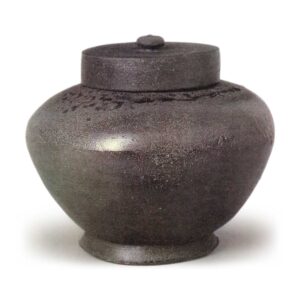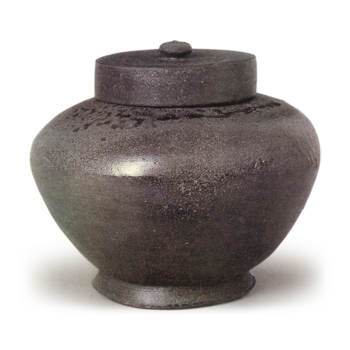
8th century
(Lid) Height 4.3cm, Bottom diameter 12.6cm, (Body) Height 17.9cm, Mouth diameter 11.7cm, Body diameter 23.5cm, Bottom diameter 13.4cm
Shosoin
Ebisu salt is an earthen salt produced in the arid northwestern region of China and was used for medicinal purposes. A small amount of it remains inside the jar. On the back of the lid, there is an ink inscription that reads, “September 18, 2nd year of the Emperor’s reign (Kounin 2), 8 kg, 7 ryo ko,” indicating the amount of salt used at the time of aeration in that year.
This medicine jar is a short-necked jar common to Sue ware of the period, but the body and lid were fired separately. The lid is of a neat shape with a high side rim and a slightly flattened bead-shaped cord. The body is of a form characteristic of the Nara period, with a slightly high base that extends outward. The mouth rim is thinly ground outward. This type of mouth rim is also seen on jar kazu jars, and is not seen anywhere else except in the production sites of Shosoin medicine jars. The original shape can be traced back to Tang Sancai, and it is thought to have been influenced by the Tang style.
The base material is of relatively high quality and fineness, and the wheel-thrown molding is thin and superbly crafted. The surface of the body from the shoulder down has been carefully shaped by the “hama-shaving” technique. There is a small gouge on the outside of the lower rim of the lid, which is common to all Shosoin pots. The ware is extremely solid and grayish-black in color, giving it a metallic appearance. The shoulders are covered with a thick natural glaze, some of which runs down to the body.
Recently, a number of Sue ware similar to Ebisu salt jars and Glauber’s jars in terms of base material, molding, and firing were discovered in the Komyoike area of the Touup kiln site group in southern Osaka, and it has become clear that Shosoin pots were fired in the Touup kilns.



